Impact of Rising Competition in Singapore Power Market: A Report
VerifiedAdded on 2022/11/15
|8
|1484
|107
Report
AI Summary
This report examines the effects of rising competition in Singapore's power market, focusing on the transition from a monopoly to a competitive market. It analyzes the role of the Energy Market Authority (EMA) in regulating the market and the impact of the Open Electricity Market (OEM) on consumers and producers. The report details the market structure before and after liberalization, highlighting the shift from Singapore Power (SP) Group's dominance to multiple retailers. It discusses the benefits of increased competition, such as lower prices and a wider variety of plans for consumers, while also addressing the long-term sustainability issues for producers, including the potential for reduced profits. The report uses figures to contrast monopoly and perfect competition and analyzes the long-run adjustments in a competitive marketplace. It concludes by emphasizing the welfare-enhancing effects of the OEM for consumers, while suggesting that the government should manage the level of competition to ensure productivity and market stability.
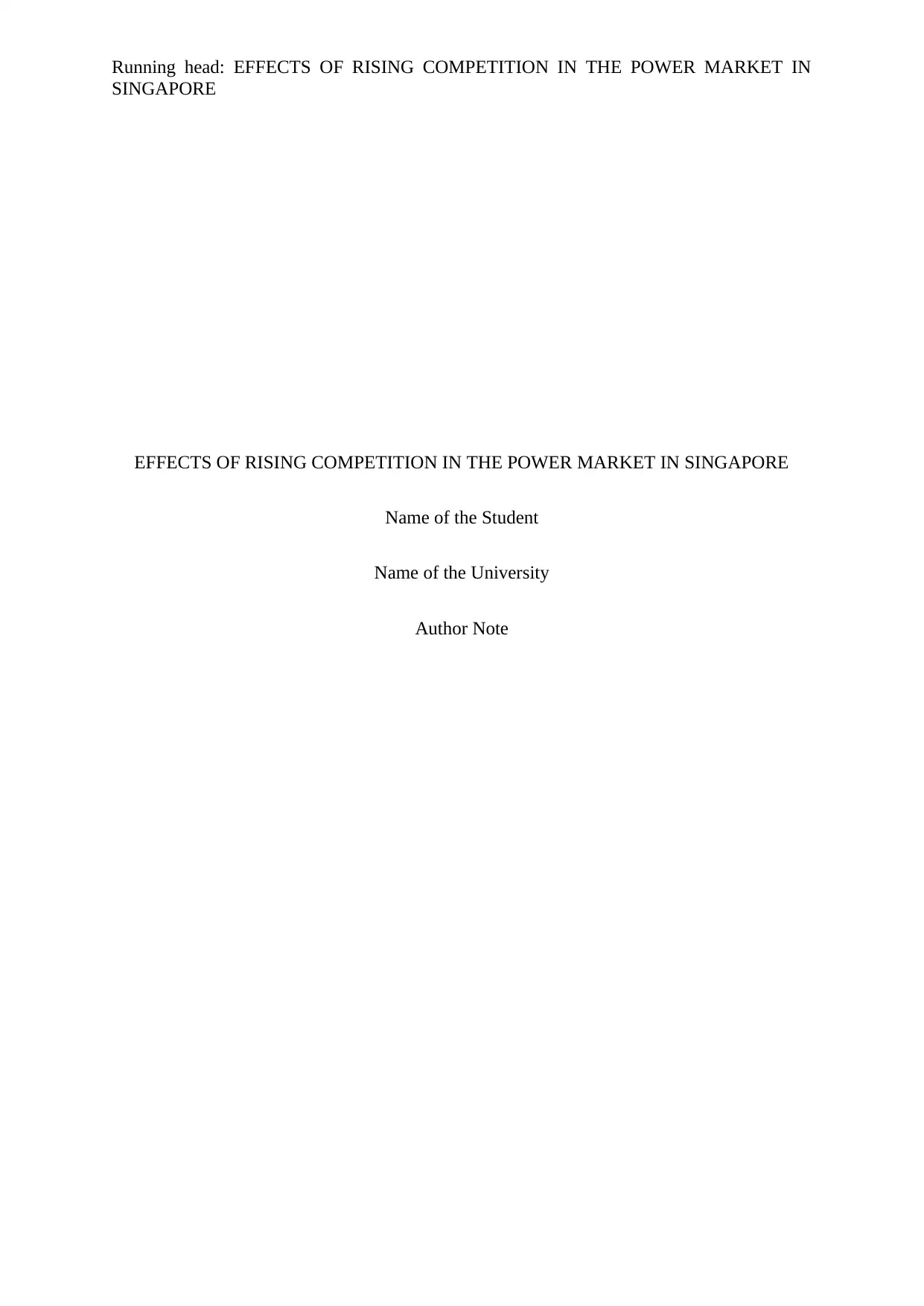
Running head: EFFECTS OF RISING COMPETITION IN THE POWER MARKET IN
SINGAPORE
EFFECTS OF RISING COMPETITION IN THE POWER MARKET IN SINGAPORE
Name of the Student
Name of the University
Author Note
SINGAPORE
EFFECTS OF RISING COMPETITION IN THE POWER MARKET IN SINGAPORE
Name of the Student
Name of the University
Author Note
Paraphrase This Document
Need a fresh take? Get an instant paraphrase of this document with our AI Paraphraser
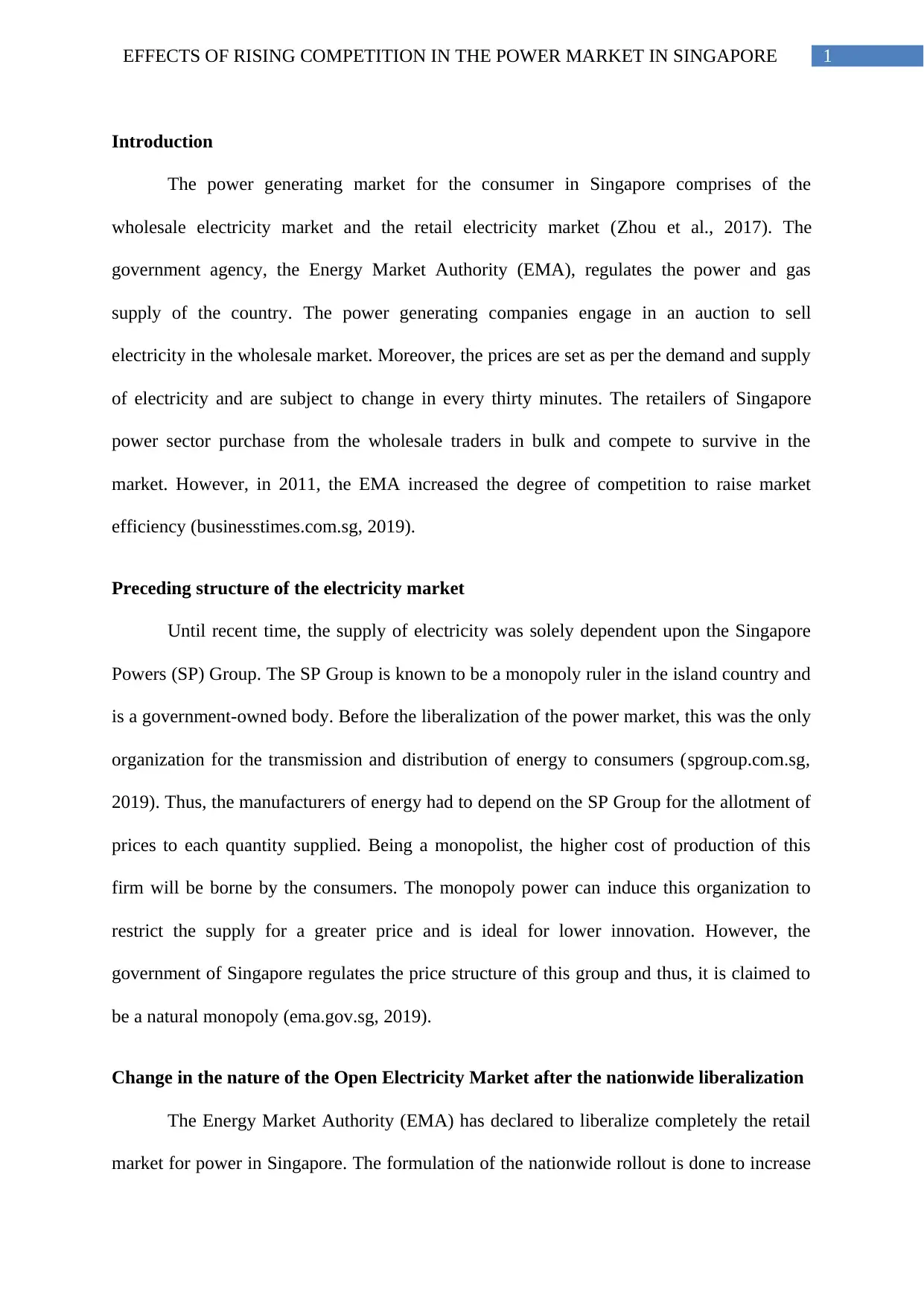
1EFFECTS OF RISING COMPETITION IN THE POWER MARKET IN SINGAPORE
Introduction
The power generating market for the consumer in Singapore comprises of the
wholesale electricity market and the retail electricity market (Zhou et al., 2017). The
government agency, the Energy Market Authority (EMA), regulates the power and gas
supply of the country. The power generating companies engage in an auction to sell
electricity in the wholesale market. Moreover, the prices are set as per the demand and supply
of electricity and are subject to change in every thirty minutes. The retailers of Singapore
power sector purchase from the wholesale traders in bulk and compete to survive in the
market. However, in 2011, the EMA increased the degree of competition to raise market
efficiency (businesstimes.com.sg, 2019).
Preceding structure of the electricity market
Until recent time, the supply of electricity was solely dependent upon the Singapore
Powers (SP) Group. The SP Group is known to be a monopoly ruler in the island country and
is a government-owned body. Before the liberalization of the power market, this was the only
organization for the transmission and distribution of energy to consumers (spgroup.com.sg,
2019). Thus, the manufacturers of energy had to depend on the SP Group for the allotment of
prices to each quantity supplied. Being a monopolist, the higher cost of production of this
firm will be borne by the consumers. The monopoly power can induce this organization to
restrict the supply for a greater price and is ideal for lower innovation. However, the
government of Singapore regulates the price structure of this group and thus, it is claimed to
be a natural monopoly (ema.gov.sg, 2019).
Change in the nature of the Open Electricity Market after the nationwide liberalization
The Energy Market Authority (EMA) has declared to liberalize completely the retail
market for power in Singapore. The formulation of the nationwide rollout is done to increase
Introduction
The power generating market for the consumer in Singapore comprises of the
wholesale electricity market and the retail electricity market (Zhou et al., 2017). The
government agency, the Energy Market Authority (EMA), regulates the power and gas
supply of the country. The power generating companies engage in an auction to sell
electricity in the wholesale market. Moreover, the prices are set as per the demand and supply
of electricity and are subject to change in every thirty minutes. The retailers of Singapore
power sector purchase from the wholesale traders in bulk and compete to survive in the
market. However, in 2011, the EMA increased the degree of competition to raise market
efficiency (businesstimes.com.sg, 2019).
Preceding structure of the electricity market
Until recent time, the supply of electricity was solely dependent upon the Singapore
Powers (SP) Group. The SP Group is known to be a monopoly ruler in the island country and
is a government-owned body. Before the liberalization of the power market, this was the only
organization for the transmission and distribution of energy to consumers (spgroup.com.sg,
2019). Thus, the manufacturers of energy had to depend on the SP Group for the allotment of
prices to each quantity supplied. Being a monopolist, the higher cost of production of this
firm will be borne by the consumers. The monopoly power can induce this organization to
restrict the supply for a greater price and is ideal for lower innovation. However, the
government of Singapore regulates the price structure of this group and thus, it is claimed to
be a natural monopoly (ema.gov.sg, 2019).
Change in the nature of the Open Electricity Market after the nationwide liberalization
The Energy Market Authority (EMA) has declared to liberalize completely the retail
market for power in Singapore. The formulation of the nationwide rollout is done to increase
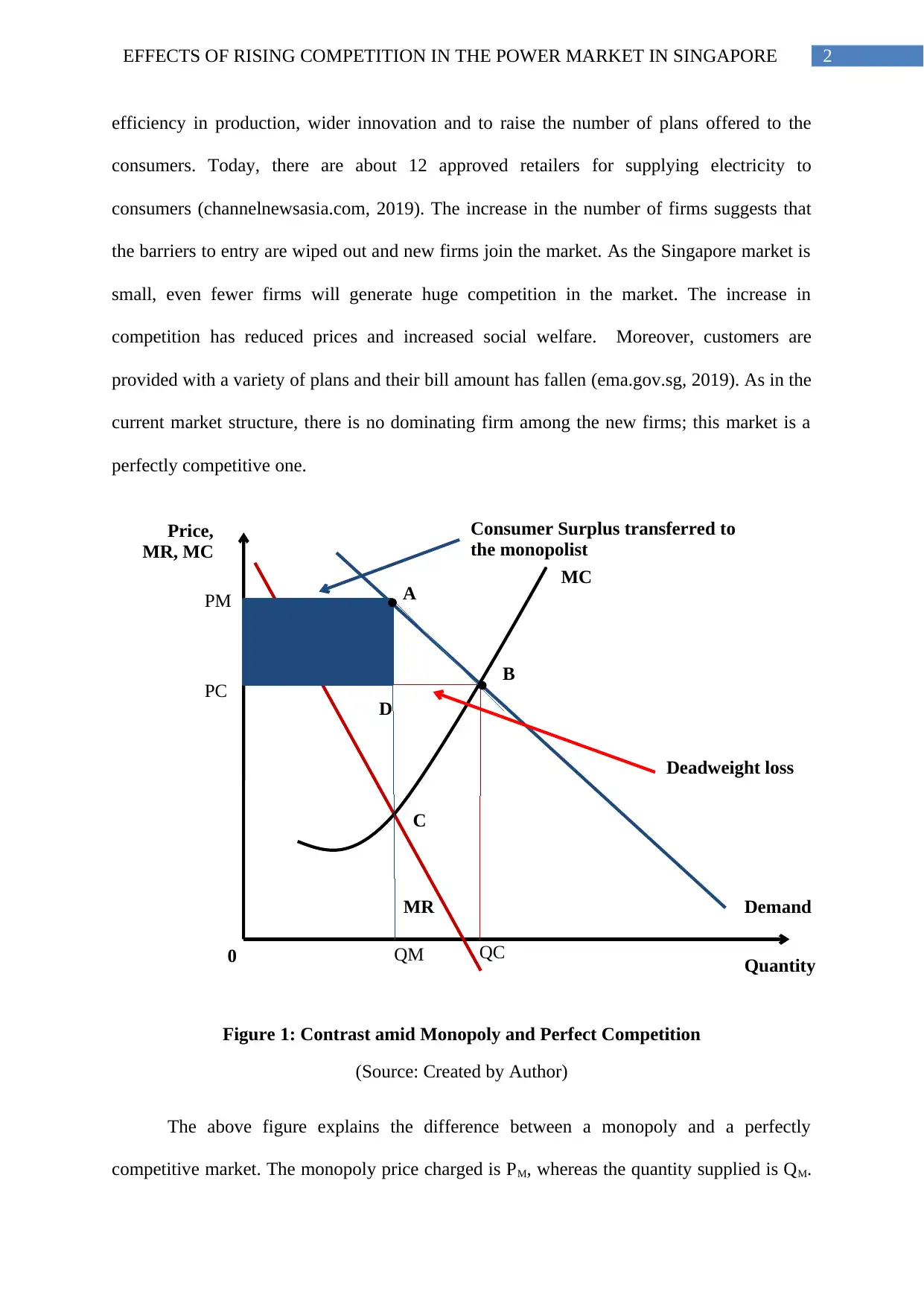
2EFFECTS OF RISING COMPETITION IN THE POWER MARKET IN SINGAPORE
Consumer Surplus transferred to
the monopolist
MC
Deadweight loss
MR Demand
A
B
C
PM
PC
QM QC
Price,
MR, MC
Quantity
D
0
efficiency in production, wider innovation and to raise the number of plans offered to the
consumers. Today, there are about 12 approved retailers for supplying electricity to
consumers (channelnewsasia.com, 2019). The increase in the number of firms suggests that
the barriers to entry are wiped out and new firms join the market. As the Singapore market is
small, even fewer firms will generate huge competition in the market. The increase in
competition has reduced prices and increased social welfare. Moreover, customers are
provided with a variety of plans and their bill amount has fallen (ema.gov.sg, 2019). As in the
current market structure, there is no dominating firm among the new firms; this market is a
perfectly competitive one.
Figure 1: Contrast amid Monopoly and Perfect Competition
(Source: Created by Author)
The above figure explains the difference between a monopoly and a perfectly
competitive market. The monopoly price charged is PM, whereas the quantity supplied is QM.
Consumer Surplus transferred to
the monopolist
MC
Deadweight loss
MR Demand
A
B
C
PM
PC
QM QC
Price,
MR, MC
Quantity
D
0
efficiency in production, wider innovation and to raise the number of plans offered to the
consumers. Today, there are about 12 approved retailers for supplying electricity to
consumers (channelnewsasia.com, 2019). The increase in the number of firms suggests that
the barriers to entry are wiped out and new firms join the market. As the Singapore market is
small, even fewer firms will generate huge competition in the market. The increase in
competition has reduced prices and increased social welfare. Moreover, customers are
provided with a variety of plans and their bill amount has fallen (ema.gov.sg, 2019). As in the
current market structure, there is no dominating firm among the new firms; this market is a
perfectly competitive one.
Figure 1: Contrast amid Monopoly and Perfect Competition
(Source: Created by Author)
The above figure explains the difference between a monopoly and a perfectly
competitive market. The monopoly price charged is PM, whereas the quantity supplied is QM.
⊘ This is a preview!⊘
Do you want full access?
Subscribe today to unlock all pages.

Trusted by 1+ million students worldwide
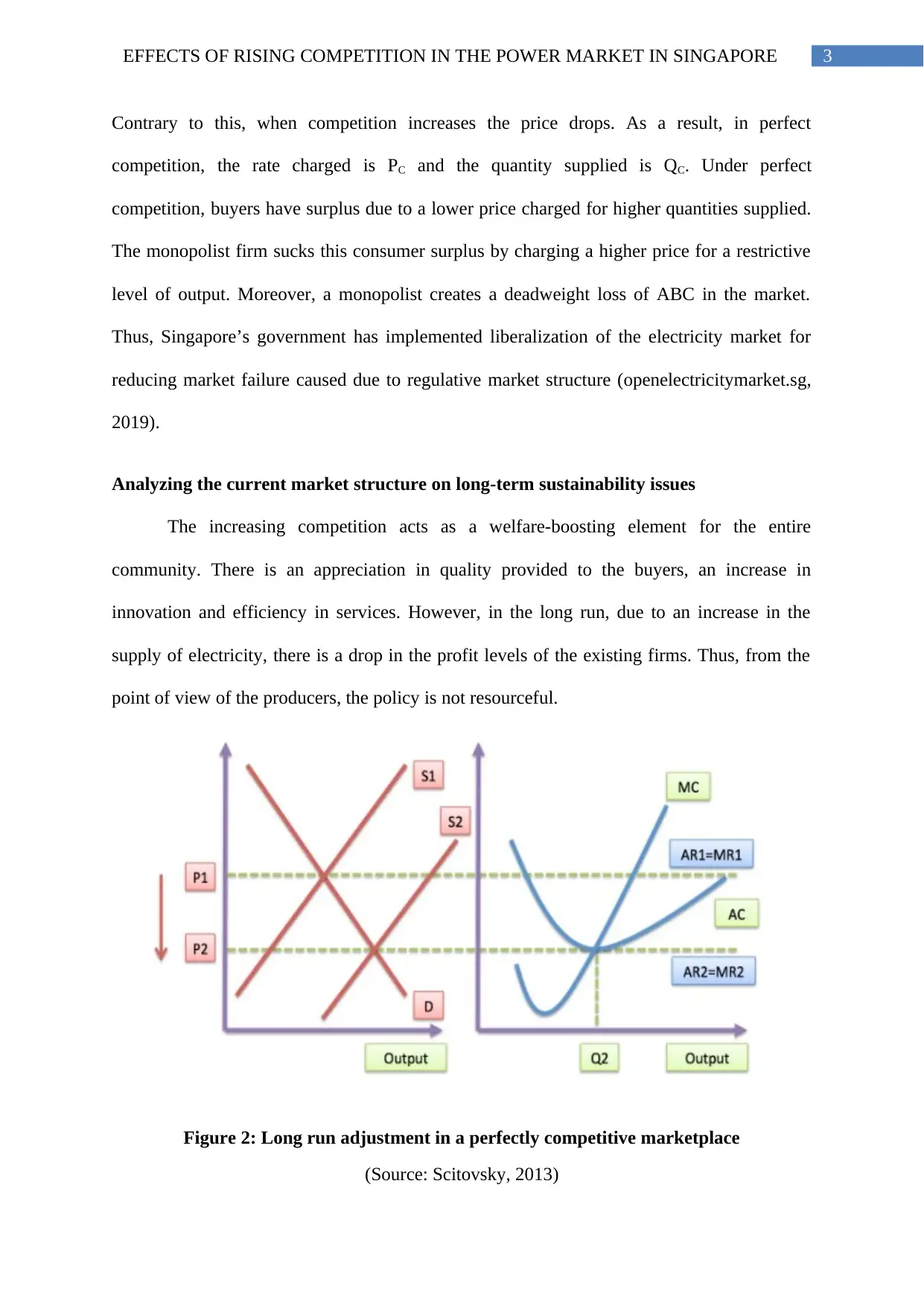
3EFFECTS OF RISING COMPETITION IN THE POWER MARKET IN SINGAPORE
Contrary to this, when competition increases the price drops. As a result, in perfect
competition, the rate charged is PC and the quantity supplied is QC. Under perfect
competition, buyers have surplus due to a lower price charged for higher quantities supplied.
The monopolist firm sucks this consumer surplus by charging a higher price for a restrictive
level of output. Moreover, a monopolist creates a deadweight loss of ABC in the market.
Thus, Singapore’s government has implemented liberalization of the electricity market for
reducing market failure caused due to regulative market structure (openelectricitymarket.sg,
2019).
Analyzing the current market structure on long-term sustainability issues
The increasing competition acts as a welfare-boosting element for the entire
community. There is an appreciation in quality provided to the buyers, an increase in
innovation and efficiency in services. However, in the long run, due to an increase in the
supply of electricity, there is a drop in the profit levels of the existing firms. Thus, from the
point of view of the producers, the policy is not resourceful.
Figure 2: Long run adjustment in a perfectly competitive marketplace
(Source: Scitovsky, 2013)
Contrary to this, when competition increases the price drops. As a result, in perfect
competition, the rate charged is PC and the quantity supplied is QC. Under perfect
competition, buyers have surplus due to a lower price charged for higher quantities supplied.
The monopolist firm sucks this consumer surplus by charging a higher price for a restrictive
level of output. Moreover, a monopolist creates a deadweight loss of ABC in the market.
Thus, Singapore’s government has implemented liberalization of the electricity market for
reducing market failure caused due to regulative market structure (openelectricitymarket.sg,
2019).
Analyzing the current market structure on long-term sustainability issues
The increasing competition acts as a welfare-boosting element for the entire
community. There is an appreciation in quality provided to the buyers, an increase in
innovation and efficiency in services. However, in the long run, due to an increase in the
supply of electricity, there is a drop in the profit levels of the existing firms. Thus, from the
point of view of the producers, the policy is not resourceful.
Figure 2: Long run adjustment in a perfectly competitive marketplace
(Source: Scitovsky, 2013)
Paraphrase This Document
Need a fresh take? Get an instant paraphrase of this document with our AI Paraphraser
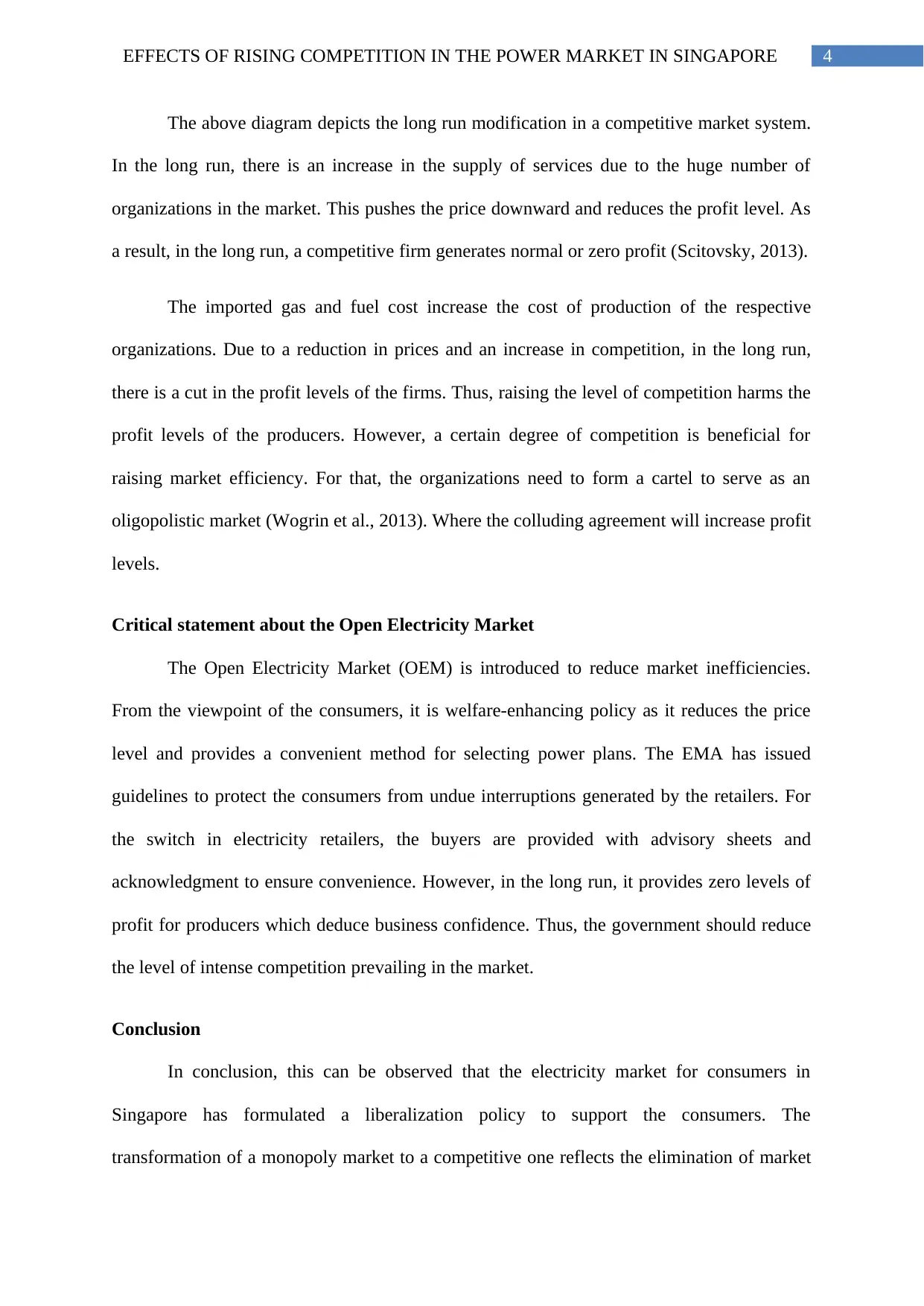
4EFFECTS OF RISING COMPETITION IN THE POWER MARKET IN SINGAPORE
The above diagram depicts the long run modification in a competitive market system.
In the long run, there is an increase in the supply of services due to the huge number of
organizations in the market. This pushes the price downward and reduces the profit level. As
a result, in the long run, a competitive firm generates normal or zero profit (Scitovsky, 2013).
The imported gas and fuel cost increase the cost of production of the respective
organizations. Due to a reduction in prices and an increase in competition, in the long run,
there is a cut in the profit levels of the firms. Thus, raising the level of competition harms the
profit levels of the producers. However, a certain degree of competition is beneficial for
raising market efficiency. For that, the organizations need to form a cartel to serve as an
oligopolistic market (Wogrin et al., 2013). Where the colluding agreement will increase profit
levels.
Critical statement about the Open Electricity Market
The Open Electricity Market (OEM) is introduced to reduce market inefficiencies.
From the viewpoint of the consumers, it is welfare-enhancing policy as it reduces the price
level and provides a convenient method for selecting power plans. The EMA has issued
guidelines to protect the consumers from undue interruptions generated by the retailers. For
the switch in electricity retailers, the buyers are provided with advisory sheets and
acknowledgment to ensure convenience. However, in the long run, it provides zero levels of
profit for producers which deduce business confidence. Thus, the government should reduce
the level of intense competition prevailing in the market.
Conclusion
In conclusion, this can be observed that the electricity market for consumers in
Singapore has formulated a liberalization policy to support the consumers. The
transformation of a monopoly market to a competitive one reflects the elimination of market
The above diagram depicts the long run modification in a competitive market system.
In the long run, there is an increase in the supply of services due to the huge number of
organizations in the market. This pushes the price downward and reduces the profit level. As
a result, in the long run, a competitive firm generates normal or zero profit (Scitovsky, 2013).
The imported gas and fuel cost increase the cost of production of the respective
organizations. Due to a reduction in prices and an increase in competition, in the long run,
there is a cut in the profit levels of the firms. Thus, raising the level of competition harms the
profit levels of the producers. However, a certain degree of competition is beneficial for
raising market efficiency. For that, the organizations need to form a cartel to serve as an
oligopolistic market (Wogrin et al., 2013). Where the colluding agreement will increase profit
levels.
Critical statement about the Open Electricity Market
The Open Electricity Market (OEM) is introduced to reduce market inefficiencies.
From the viewpoint of the consumers, it is welfare-enhancing policy as it reduces the price
level and provides a convenient method for selecting power plans. The EMA has issued
guidelines to protect the consumers from undue interruptions generated by the retailers. For
the switch in electricity retailers, the buyers are provided with advisory sheets and
acknowledgment to ensure convenience. However, in the long run, it provides zero levels of
profit for producers which deduce business confidence. Thus, the government should reduce
the level of intense competition prevailing in the market.
Conclusion
In conclusion, this can be observed that the electricity market for consumers in
Singapore has formulated a liberalization policy to support the consumers. The
transformation of a monopoly market to a competitive one reflects the elimination of market
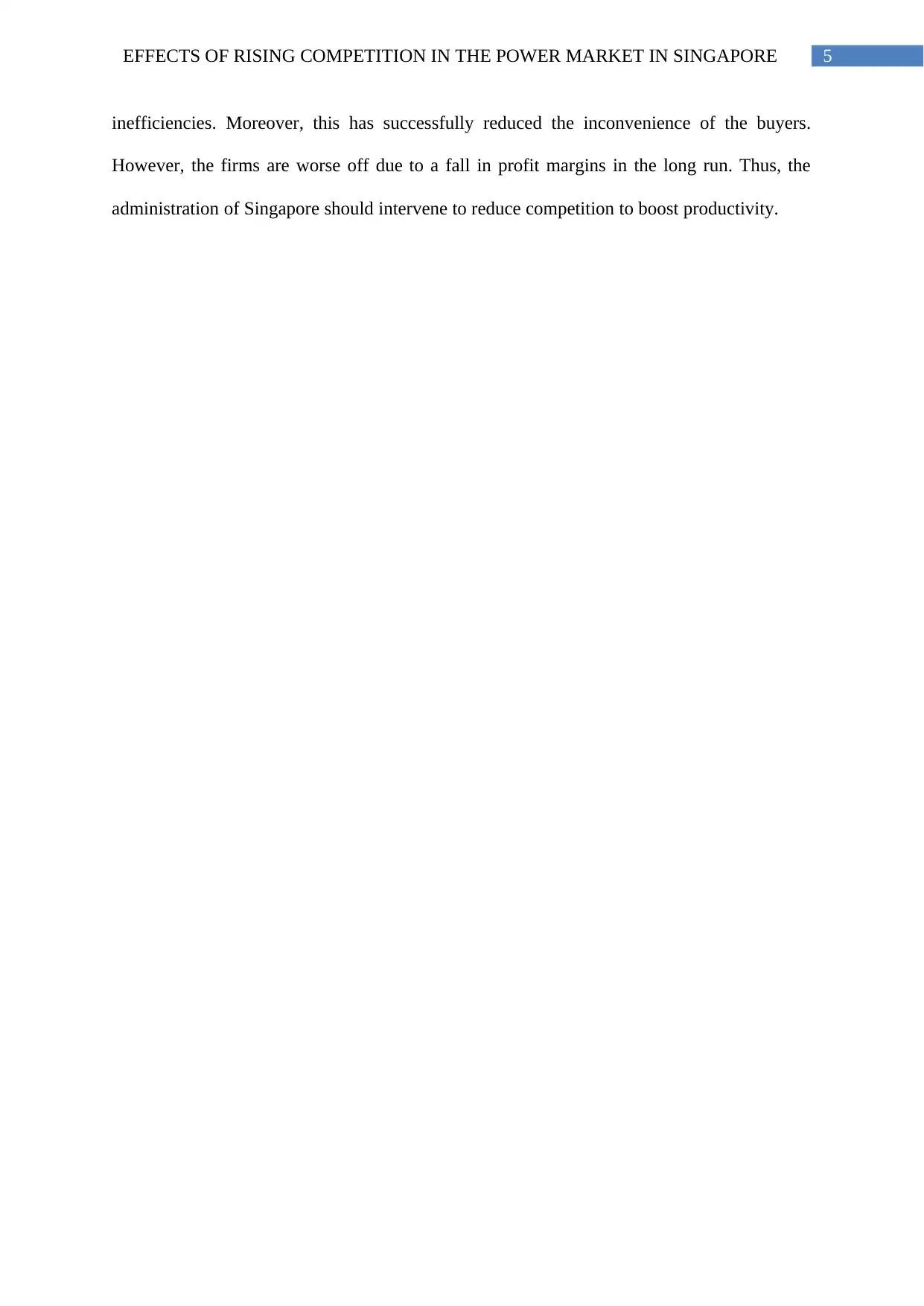
5EFFECTS OF RISING COMPETITION IN THE POWER MARKET IN SINGAPORE
inefficiencies. Moreover, this has successfully reduced the inconvenience of the buyers.
However, the firms are worse off due to a fall in profit margins in the long run. Thus, the
administration of Singapore should intervene to reduce competition to boost productivity.
inefficiencies. Moreover, this has successfully reduced the inconvenience of the buyers.
However, the firms are worse off due to a fall in profit margins in the long run. Thus, the
administration of Singapore should intervene to reduce competition to boost productivity.
⊘ This is a preview!⊘
Do you want full access?
Subscribe today to unlock all pages.

Trusted by 1+ million students worldwide
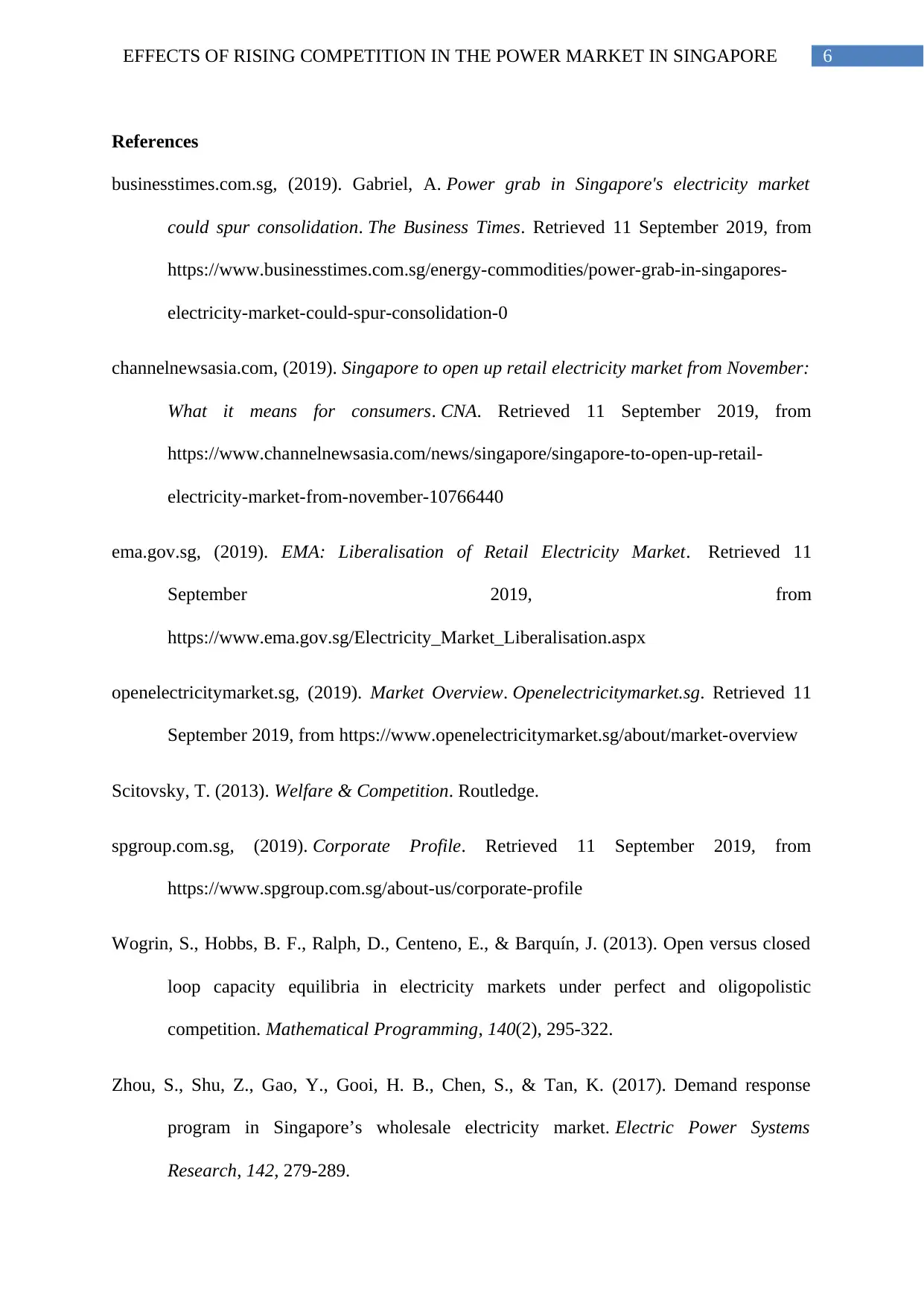
6EFFECTS OF RISING COMPETITION IN THE POWER MARKET IN SINGAPORE
References
businesstimes.com.sg, (2019). Gabriel, A. Power grab in Singapore's electricity market
could spur consolidation. The Business Times. Retrieved 11 September 2019, from
https://www.businesstimes.com.sg/energy-commodities/power-grab-in-singapores-
electricity-market-could-spur-consolidation-0
channelnewsasia.com, (2019). Singapore to open up retail electricity market from November:
What it means for consumers. CNA. Retrieved 11 September 2019, from
https://www.channelnewsasia.com/news/singapore/singapore-to-open-up-retail-
electricity-market-from-november-10766440
ema.gov.sg, (2019). EMA: Liberalisation of Retail Electricity Market. Retrieved 11
September 2019, from
https://www.ema.gov.sg/Electricity_Market_Liberalisation.aspx
openelectricitymarket.sg, (2019). Market Overview. Openelectricitymarket.sg. Retrieved 11
September 2019, from https://www.openelectricitymarket.sg/about/market-overview
Scitovsky, T. (2013). Welfare & Competition. Routledge.
spgroup.com.sg, (2019). Corporate Profile. Retrieved 11 September 2019, from
https://www.spgroup.com.sg/about-us/corporate-profile
Wogrin, S., Hobbs, B. F., Ralph, D., Centeno, E., & Barquín, J. (2013). Open versus closed
loop capacity equilibria in electricity markets under perfect and oligopolistic
competition. Mathematical Programming, 140(2), 295-322.
Zhou, S., Shu, Z., Gao, Y., Gooi, H. B., Chen, S., & Tan, K. (2017). Demand response
program in Singapore’s wholesale electricity market. Electric Power Systems
Research, 142, 279-289.
References
businesstimes.com.sg, (2019). Gabriel, A. Power grab in Singapore's electricity market
could spur consolidation. The Business Times. Retrieved 11 September 2019, from
https://www.businesstimes.com.sg/energy-commodities/power-grab-in-singapores-
electricity-market-could-spur-consolidation-0
channelnewsasia.com, (2019). Singapore to open up retail electricity market from November:
What it means for consumers. CNA. Retrieved 11 September 2019, from
https://www.channelnewsasia.com/news/singapore/singapore-to-open-up-retail-
electricity-market-from-november-10766440
ema.gov.sg, (2019). EMA: Liberalisation of Retail Electricity Market. Retrieved 11
September 2019, from
https://www.ema.gov.sg/Electricity_Market_Liberalisation.aspx
openelectricitymarket.sg, (2019). Market Overview. Openelectricitymarket.sg. Retrieved 11
September 2019, from https://www.openelectricitymarket.sg/about/market-overview
Scitovsky, T. (2013). Welfare & Competition. Routledge.
spgroup.com.sg, (2019). Corporate Profile. Retrieved 11 September 2019, from
https://www.spgroup.com.sg/about-us/corporate-profile
Wogrin, S., Hobbs, B. F., Ralph, D., Centeno, E., & Barquín, J. (2013). Open versus closed
loop capacity equilibria in electricity markets under perfect and oligopolistic
competition. Mathematical Programming, 140(2), 295-322.
Zhou, S., Shu, Z., Gao, Y., Gooi, H. B., Chen, S., & Tan, K. (2017). Demand response
program in Singapore’s wholesale electricity market. Electric Power Systems
Research, 142, 279-289.
Paraphrase This Document
Need a fresh take? Get an instant paraphrase of this document with our AI Paraphraser
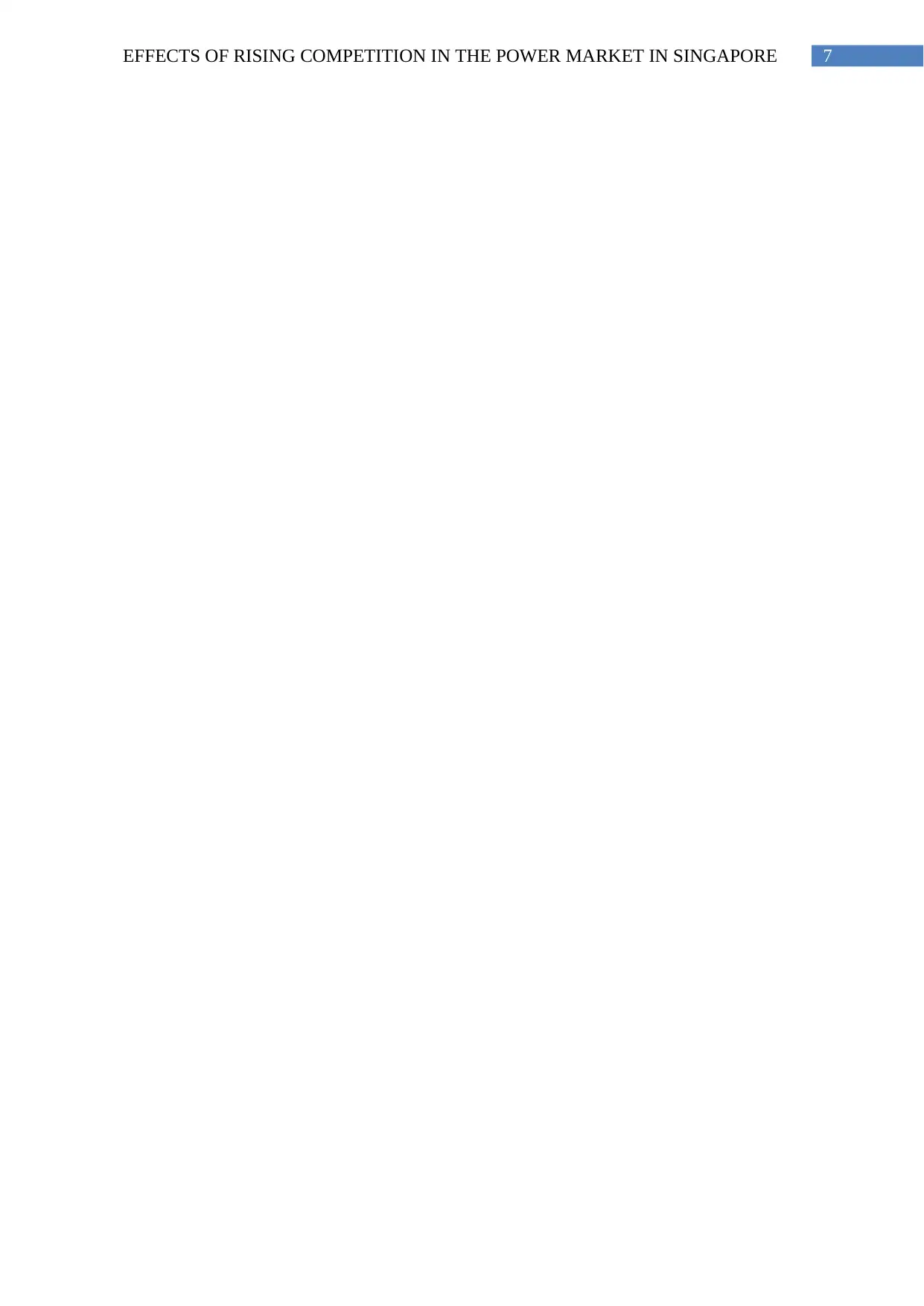
7EFFECTS OF RISING COMPETITION IN THE POWER MARKET IN SINGAPORE
1 out of 8
Related Documents
Your All-in-One AI-Powered Toolkit for Academic Success.
+13062052269
info@desklib.com
Available 24*7 on WhatsApp / Email
![[object Object]](/_next/static/media/star-bottom.7253800d.svg)
Unlock your academic potential
Copyright © 2020–2025 A2Z Services. All Rights Reserved. Developed and managed by ZUCOL.


